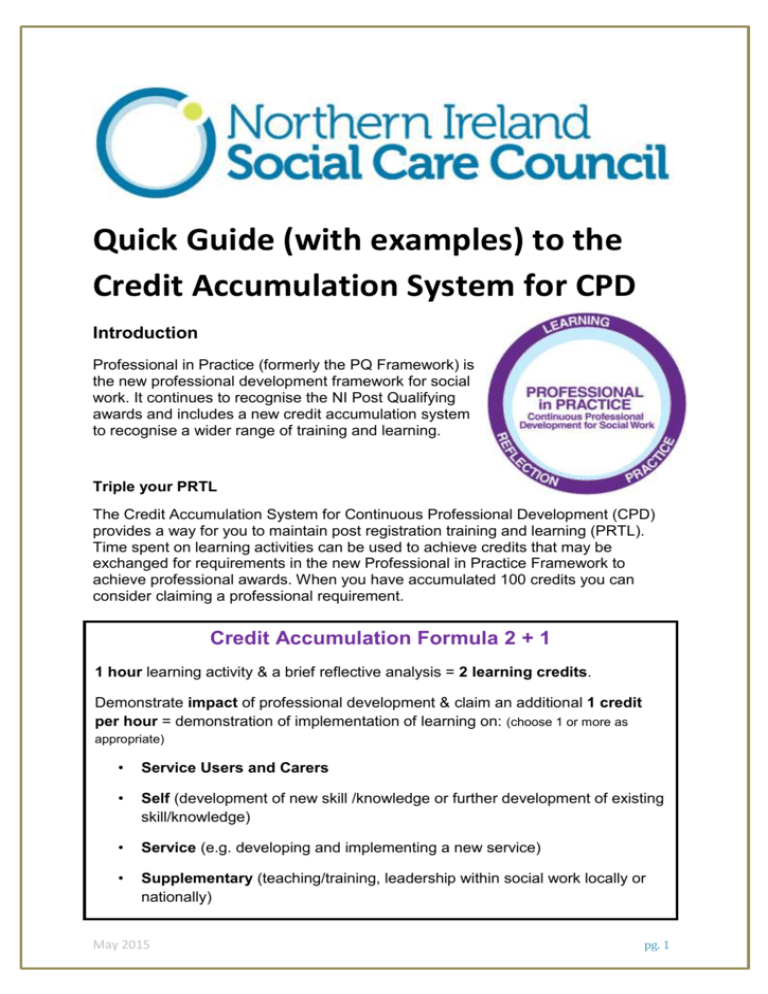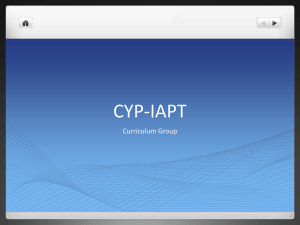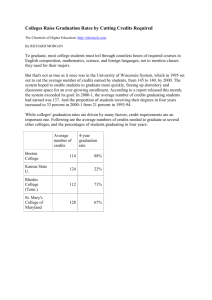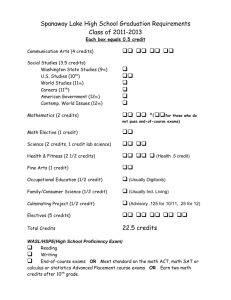2015_5_7_Guide__to_credit_with_examples_web
advertisement

Quick Guide (with examples) to the Credit Accumulation System for CPD Introduction Professional in Practice (formerly the PQ Framework) is the new professional development framework for social work. It continues to recognise the NI Post Qualifying awards and includes a new credit accumulation system to recognise a wider range of training and learning. Triple your PRTL The Credit Accumulation System for Continuous Professional Development (CPD) provides a way for you to maintain post registration training and learning (PRTL). Time spent on learning activities can be used to achieve credits that may be exchanged for requirements in the new Professional in Practice Framework to achieve professional awards. When you have accumulated 100 credits you can consider claiming a professional requirement. Credit Accumulation Formula 2 + 1 1 hour learning activity & a brief reflective analysis = 2 learning credits. Demonstrate impact of professional development & claim an additional 1 credit per hour = demonstration of implementation of learning on: (choose 1 or more as appropriate) • Service Users and Carers • Self (development of new skill /knowledge or further development of existing skill/knowledge) • Service (e.g. developing and implementing a new service) • Supplementary (teaching/training, leadership within social work locally or nationally) May 2015 pg. 1 This guidance is aimed at helping you consider how you make the most of your professional development and claim professional credits. It is designed to be flexible, tailored to your own professional development needs and career path. The guide is not intended to be prescriptive; the following examples are to help you consider how you can apply this system to make the most out of your training and learning. This system is best suited to small bite-sized pieces of learning, for larger pieces of learning the current individual assessment route (IAR) might be more appropriate. The important aspects to the credit accumulation system are: increasing the linkage between CPD and reflective supervision credits being based on the value of the learning and including a record of reflection and learning points developing practitioners across the context of their professional practice maintaining a record of learning and reflection for external scrutiny that multiple methods of learning are appropriate Examples of learning activities: Example 1 Attendance on 1 day training on direct payments (DP) with reflective analysis = 12 credits Practitioner made contact with a local (DP) champion within the Trust and gained further advice and support. Following training, practitioner reviewed her cases and believed that a number of service users would be eligible for direct payments. She spoke to the service users and introduced the concept of DP. This option was not taken up by all, however, a number of service users were happy to take up the use of DP. This has resulted in an additional 5 referrals for DP. This learning and the subsequent reflection was examined within supervision, recorded within supervision records and verified by her line manager/professional supervisor. Therefore, because the practitioner was able to identify that she had applied the learning (demonstration of implementation of learning on service users and carers, self and service) she was able to claim an additional 1 learning credit for each hour of such learning activity = 6 credits Total credits claimed = 18 N.B in this example one training day equates to 6 hrs May 2015 pg. 2 This practitioner was able to log key learning from the training, it challenged some preconceptions that she had about direct payments and promoted her to consider this new learning in light of her own caseload. She proactively followed up the learning after the training day and made links with someone within her organisation who provided her with additional knowledge and support. The culmination of this learning was that she was able to integrate a new model of work into her practice with clear outcomes for the service users. Example 2 Attendance on 2 day training on neglect with reflective analysis of key learning = 24 credits After the training, the practitioner reviewed difficult cases within the team in particular past concerns that had come to her attention. From this, as well as the team discussion, she was able to identify the cumulative impact of neglect in two cases specifically, which resulted in referral to a specialist project. This learning and the subsequent reflection was examined within supervision and recorded within supervision records and verified by her line manager/professional supervisor. Because the practitioner was able to identify impact (demonstration of implementation of learning on service users and carers, self and service) she was able to claim an additional 1 learning credit for each hour of such learning activity = 12 credits Total credits claimed = 36 credits This practitioner was able to log key learning from the training. She further developed her knowledge about child neglect and was able to re-assess her caseload. She also consulted with the team who supported her to consolidate the new learning. She formulated a clearer assessment that incorporated the cumulative effect of neglect and gained confidence to refer the case through to the single point of entry team who then instigated a child protection investigation. This learning and the subsequent reflection was examined within the team and supervision and was recorded within supervision records. May 2015 pg. 3 Example 3 Attendance at a 1 day conference focussed on Leadership within the social work profession with reflective analysis of key learning = 12 credits Manager attended a seminar within the conference that promoted a model of reflection eg. (Houston 2013). After the conference the manager read the model in more detail and introduced it to the team, presenting key elements of the model. She also tested the model in two supervision sessions and reflected on key learning. This learning and the subsequent reflection was examined within supervision and recorded within supervision records and verified by her line manager/professional supervisor. Because the manager was able to identify impact (demonstration of implementation of learning on self and service) she was able to claim an additional 1 learning credit for each hour of such learning activity = = 6 credits Total credits claimed = 18 This Manager attended a 1 day conference and focussed specifically on 1 seminar as the key learning. She spent time after the conference reading about a model that had been presented in relation to reflective social work. She introduced the model to her team and applied it to a small number of supervision sessions. She used the learning from this to consider how to integrate it into her role as manager within the team. Example 4 Attendance at a 1 day training on Restorative Interventions with reflective analysis of key learning = 12 credits At the training the practitioner completed an evaluation to identify how they might use the new learning. This was discussed in supervision (staff member and line manager). They reflected on the training outlining how they had progressed their evaluation steps and intended actions as a result e.g. “ as a result of attending the training I have considered how I will use a restorative perspective in reviewing case plans with 5 individuals I supervise” At second monthly supervision the staff member and line manager discussed the impact of applying the new knowledge – “as a result of incorporating restorative interventions into my supervision plan I have evidenced a change in engagement with 3 service users and introduced community based support links – the extended family are able to engage with a wider network of help services”. = 12 credits + 6 = 18 credits with application. May 2015 Total credits claimed = 18 pg. 4 This practitioner attended a 1 day in house training event and he was able to develop his knowledge of using restorative principles within a prison environment. He consulted with his line manager and presented this information within the multidisciplinary team incorporating prison officers and psychologists. In order to consolidate his new learning he was able to agree action steps for supervision plans which involved victim awareness work and cognitive behavioural approaches to address the consequences of offending behaviours. Through reflection on actions he was able to evidence the outcomes of the new learning through caseplans and referrals to other community based resources and his supervision minutes recorded his ongoing reflection and application of learning. Example 5 Attendance at 1 day audit of RoSH assessment and recording in relation to prison based assessments (Risk of Serious Harm Audit) with reflective analysis of key learning = 12 credits At the audit participants completed evaluation tools to audit PBNI objectives re RoSH assessments and recordings. At monthly supervision the line manager discussed their refection on the audit process and preliminary findings with Assistant Director – discussion addressed practice issues for their staff and consideration of action steps to address change or maintenance of targets– proposals were agreed for bringing this information to the team members / wider PBNI staff groups Manager presented the information to her staff team and monitored agency records within her team area – using team meetings to develop gaps in application and supervision with individuals to support reflective practices she cascaded her recent knowledge and learning to the team. Specific actions steps were identified for the team – including additional training activities and continued team support. = 12 credits + 6 = 18 credits with application. Because the manager was able to identify impact (demonstration of implementation of learning on self and service) she was able to claim an additional 1 learning credit for each hour of such learning activity = 12 credits + 6 = 18 credits with application. Total credits claimed = 18 May 2015 pg. 5 This area manager considered the learning from previous managerial training which had been used to claim PiP programme requirements and used this to reflect and apply the learning from conducting an audit including the research base which underpinned such investigation. She was mindful of recording her developmental activities in the supervision minutes with her Assistant Director but also through minutes of team meetings with staff and the cascade of information sharing through individual supervision. Through contributing to the evaluation of the research base created through the audit process she demonstrated contribution to the working situation both within her own team and the wider organisation. In all of the above examples the registrant would be expected to ensure the following: a record of the developmental activity personal learning acquired from the activity relevance to his or her working situation To claim the impact factor (credit × 1) the practitioner/manager would be expected to include a ‘demonstration of application of new learning’. NISCC offers a range of products to support social workers and their employers to engage with the Framework. They are all free and available to access on the NISCC website Introduction to PiP - An interactive guide using Prezi software that outlines the detail of how to make best use of PiP PiP Credit Accumulation Guide - A short animation that describes the PiP credit accumulation PiP Verification of Learning Guide - A short animation that supports line managers to verify learning as part of credit accumulation Reflective Practice: A Model for Supervision and Practice in Social Work Reflection is central to on-going learning and development. Use of the model provides a structure that supports reflective learning and encourages evidence-based practice. For further information and development updates on PiP please visit the NISCC website: www.niscc.info May 2015 pg. 6








